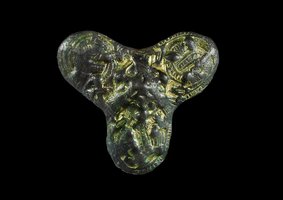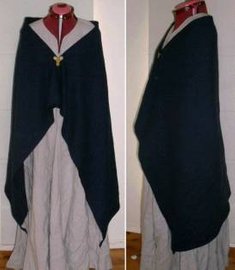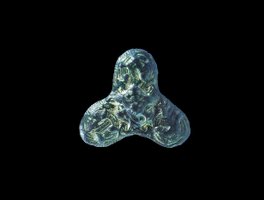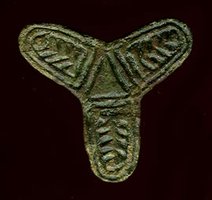The trefoil brooch - where did it came from ?
Before going back to another part of equistarian equipment, this week I like to tell something more about a true characteristic Viking Age feature in jewellry, the trefoil brooch.
Brooches of this type were used to fasten a cloak or shawl on the breast. The form is modelled on Carolingian trefoil fittings from sword-belts of the ninth century, presumably either seized by the Vikings in raids on the Continent, or perhaps obtained peacefully through trade or the exchange of gifts. The decoration, however, uses animal rather than plant motifs, a style with which the Vikings were familiar. Simpler versions appear to have been mass-produced. Although appeared to modelled on Carolingian trefoil fittings, the trefoil model already shows up in Roman times, see here.
As one can see here the sword strap distributor in my collection is modelled in this trefoil shape, accidentally at first considered by me as a trefoil brooch (though in Iceland an example was reused as a trefoil brooch, and who can blame them ;)
The viking truly Scandinavian style trefoil brooch on the image above and just here under is - although it shows clear signs of being worn - a finely made and highly ornate gilt copper-alloy brooch. It is comprising a central circular boss and three lobed extensions.
The profile of the brooch is dished with the pin and catchplate housed beneath. The decoration comprises looped and knotted serpentine creatures in Borre/Jellinge Style surrounding a hexagonal "rosette" motif of conjoined animal heads. Most books define this kind of brooch as Borre Style.
Showing his highly ornate nature, this trefoil brooch can be addressed as Scandinavian. The trefoil brooch (just like the simpler version imaged beneath) was found in England.
Many examples (although 'many' is a relative statement here) found in England are in fragmentary condition. One the one hand because of soil conditions, when fertilizer and pesticides had been used, causing corroding of the artefacts. On the other had, and this is the case with the simpler versions, like the trefoil brooch on the right beneath corner, because of their lesser quality forthcoming out of mass production and the way they were casted. The debased ornament on these brooches make them Anglo-Scandinavian products.
A true example of the Anglo-Scandinavian Style is a clay mould for a trefoil brooch combining the Borre Style with Anglo-Saxon animal motifs, wich was found in York with pottery of the late tenth or early eleventh century.
Here an example of a very fragmentated trefoil brooch of Anglo-Scandinavian type, found near Norwich. The lobes of this type of trefoil brooch very vurnable to breakage.
Until 2008, in England,a total of 18 Scandinavian style trefoil brooches were found, and a number of 29 Anglo-Scandinavian. Because of the fragmentary condition, 26 examples remained unclassifiable, making up to a total of 73 brooches. This number making them quite a rare find, and even rarer turning up in antiquities market.
Most trefoil brooches appear in the area of Viking-Age Denmark. Numerous trefoil brooch mould fragments heve been recovered at Hedeby.
Link to last week's blog January 22th 2015
References:
Francheski, G. - Jorn, A. and Magnus B., Bird, Beast and Man in Nordic Iron Age Art;
fig. 148 - Carolingian trefoil ornament of silver with plant ornamentation
fig. 212 - trefoil brooch of bronze with ornaments in Borre Style.
Hall, Viking Age York, p. 110;
Hammond, B., British Artefacts, Volume 2 - Middle Saxon & Viking 2010, fig. 1.1.5-a and fig. 1.1.5-b;
Kershaw, J.F., Viking Identities: Scandinavian Jewellry in England, 2013, p. 82-86, Trefoil brooches with geometric decoration (Type G); (colour) Plate 6;
Maixner, B, Die gegossenen kleeblattförmigen Fibeln der Wikingerzeit aus Skandinavien, Universitätsforschungen zur Prähistorischen Archäologie, aus dem Institut für Ur- und Frühgeschichte der Universität Kiel, Band 116, 2005, - The Scandinavian gilded trefoil brooch: Taf. 12 Kleeblattfibeln. Dekortype Z 1.5 (see description on p. 306, no. 428) and Taf. 41-45 Kleeblattfibeln vom Typ Z 1.5; The Anglo-Scandinavian ('herringbone') trefoil brooch: Taf. 35. Kleeblattfibeln des Typs G.1.3.1;
McLeod, The Beginning of Scandinavian Settlement in England; The Viking 'Great Army' and Early Settlers, c. 865 - 900, 2014, p.160;
Mills, N., Saxon & Viking artefacts, 2001, p. 54, fig. V115;
Murawski, P.G., Benet's artefacts of England & the United Kingdom, Milennium Second Edition 2003, p. 315, fig. V07.0201;
The Portable Antiques Scheme Database: http://finds.org.uk/database/search/results/q/trefoil+brooch
More images of diverse trefoil brooches:
https://nl.pinterest.com/cathyr19355/trefoil-brooches/
http://www.pbase.com/hajar/image/152328602
Well. I could have been with these stones until after dark, but as my wife wanted to travel on.. well.. I see you again, some day, hogback stones from Gosforth. And if you happen to be there one day, do not forget that monument on the outside...
Further on with the Cumbrian hogbacktour !
In - yes, luckily again in - St. Peter's church in Heysham, there is a truly beautiful hogback stone. The guide told us, it had been studyied by Thor Ewing, a writer, in 2000. in 'Understanding the Heysham hogback' A tenth century sculpted stone monument and its context (link), Thor Ewing tells in detail what he dicovered on the both sides of this hogback stone.
Just being brought in the church as late as the 1970's accompanied with some protest here and there among the church visitors, considered as being a token of old paganism, it had been remarkably nice preserved, and a lot of detail can be seen, still. Truly worthwile a visit.
I had a small debate with the guide in the church if the - zoomorphic, in my opinion - faces on the sides were lions (or hippo's). The guide doubted if the vikings could have known about lions. Well I guess so, concerning the runes on the Ancient Greek lion statue at the Arsenal, Venice. For example. Vikings did travel south..
But when he told me he was doubting the vikings 'discovered' (as the native inhabitants were of course, in the first place) America before Columbus, I decided to rest my case..
One has to know when to start and to end a conversation ..
Just discovered the book in a bookstore written by Geoff Holder - The guide to the mysterious Lake District, I knew there had to be another hogback stone in Lowther, St. Micheal's Church. With a promising image described in the text of 'a naval and a land-based force of shield-bearing vikings above a fish and what might be a coiled sea serpent. On the reverse is a row of female figures with snakes, possibly a representation of the hideous hag Hel'. Wow. If that did not sound as a true pagan promised land ..
Not complaing too much after all we have seen, this visit was the dissapointing one of them all. But if you wife states 'I am happy to have seen them' and I am answering 'Measuring is knowing' and the even more obligate verb 'handling 'if we did not see it at all, we wouldn't have known anything at all of how they were looking' the glass was again half full, at the last day of our journey..
The hogback stone appeared to be just being tolerated within the entrance segment part of the church. As something you never use anymore but you do not throw away - entirely. That sort of feeling emerged when seeing this hogback asylum seekers.. Bed, bath and bread, ás we say in Dutch, but no luxury at all and standing on some outcuts of wood, you would balance the table with at home..
Come on, St. Micheal's Church.. care a bit more of your 'children' !
This hogback stone was moved in the church in 1907. Hogback stones layed partially buried in the churchyard before it was dug up and moved into the church.
The promising depiction of a longship - as certainly can be seen after some studying - see http://vikingminds.co.uk/pages/longship
we have missed !
The stone itself is (157 x 50 x 30 cm) and very worn.
The hogback stones in Cumbria - very diverse in quality, but everyone worth a visit ! Especially on a gloomy day in late October ...
The churches to visit - see photos of resp. St. Andrew's church in Penrith, St. Mary's church in Gosforth, St. Peter's church in Heysham and St. Micheal's church in Lowther.
Did I miss out on another one in Cumbria ? Let me know !
In a next blog I will take you to four - still remaining utterly mysterious- statues 'guarding' the graveyard of St. Andrew's church in Dacre..
For the last blog of October 9th see this link.
References: (as always, links to where the books can be ordered are attached).
Edwards, B.J.N. Vikings in North West England - The artifacts (1998);
Emery, Gordon, CURIOUS CUMBRIA, The Lake District & Beyond: A celebration of Cumbria (2023)
Ewing, T. 'Understanding the Heysham hogback' A tenth century sculpted stone monument and its context ;
Hall, R. Viking Age archaeology in Britain and Ireland (first printed 1990, reprinted with amendments in 1995);
Holder, G. The guide to the mysterious Lake District (2009)
possibly also (as there within the part of Cumbria dealing with Carlisle, the Eden Valley, Barrow-in-Furness, Whitehaven and the west coast is being dealed with)
Holder, G. Paranormal Cumbria (2010)
http://vikingminds.co.uk/pages/longship



